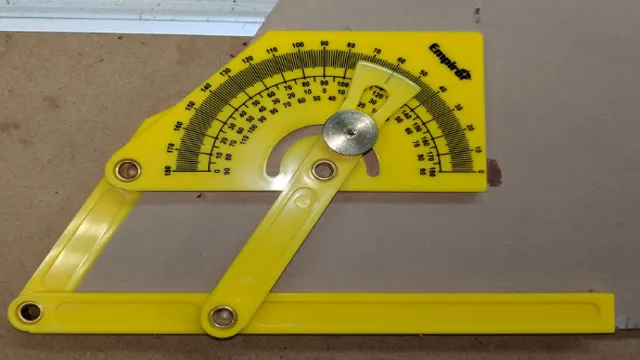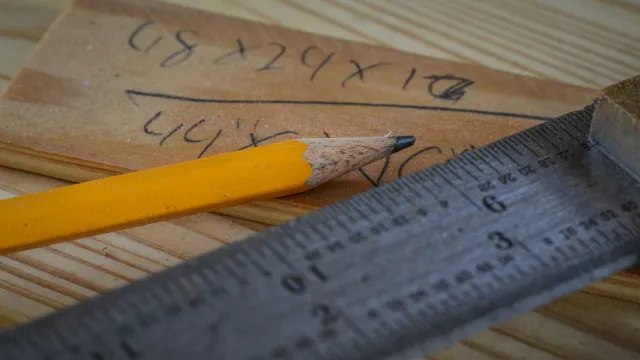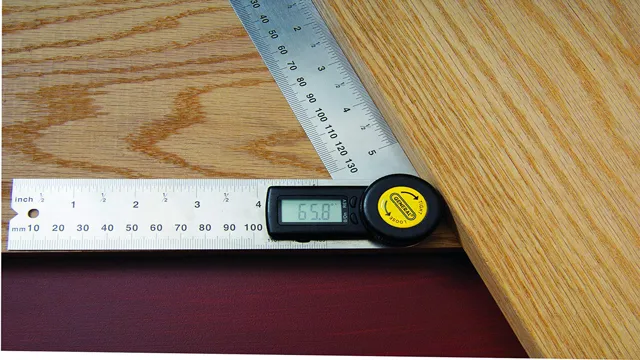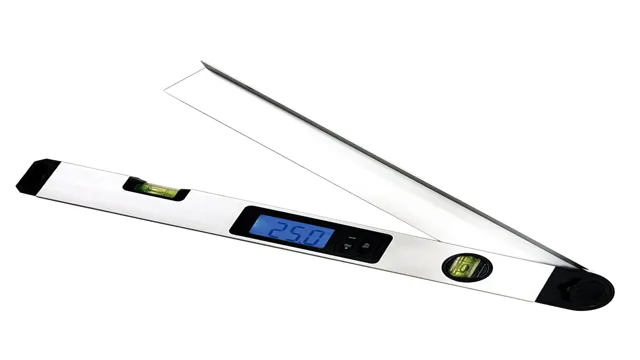How to Use Protractor Angle Finder: A Comprehensive Guide
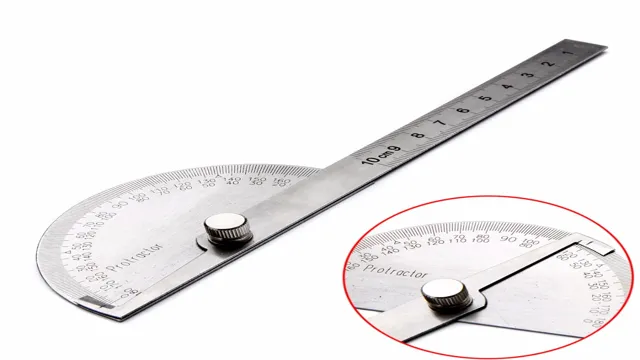
Have you ever found yourself struggling to measure angles accurately? Whether you’re a professional carpenter, DIY enthusiast or just someone trying to hang a picture straight, measuring angles can be tough without the right tools. That’s where the protractor angle finder comes in. This handy device allows you to measure angles with precision and ease, making your tasks simpler and more efficient.
In this blog post, we’ll explore how to use the protractor angle finder, why it’s essential to have in your toolbox, and tips to help you get the most out of this tool. So, let’s dive in and discover how this nifty little gadget can revolutionize the way you work with angles.
What is a Protractor Angle Finder?
If you’re looking to get precise measurements for angles, the protractor angle finder is a great tool to use. This handy device can help you measure the angle of an object or the angle between two objects. Using a protractor angle finder can be a bit tricky if you’ve never used one before, so it’s important to follow a few key steps to ensure you get accurate results.
First off, make sure your protractor is properly aligned by aligning the base of the protractor with the bottom edge of the object you’re measuring or the line you’re using as a reference. Then, read the angle measurement on the protractor using the base line as your reference point. With a little practice, you can become an expert at using a protractor angle finder for all your angle measurement needs.
Definition and Purpose
A protractor angle finder is a measuring tool used to measure angles between two intersecting lines. It consists of a semi-circular ruler with degree markings and a moving arm that can be lined up with the lines to be measured. This tool is specifically designed for architects, engineers, and carpenters, but it can also be used in various other fields that require angle measurements.
The purpose of a protractor angle finder is to ensure precise measurements for accurate construction or engineering work. It is a handy tool that saves time and eliminates the guesswork that comes with manual measurements. Using a protractor angle finder is straightforward: simply line up the moving arm with the angle’s vertex and read the degree measurement on the protractor’s scale.
Whether you are building a house or working on a DIY project, a protractor angle finder is a must-have tool to ensure that your work is accurate and efficient.
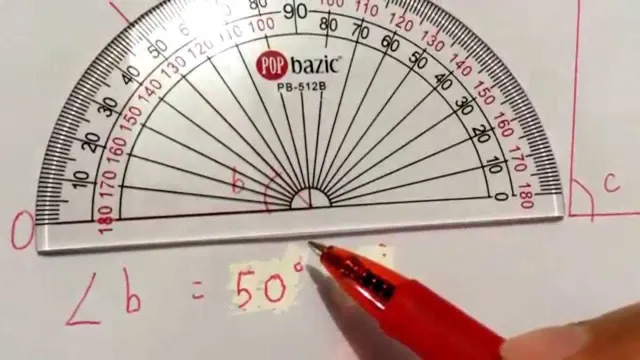
Types of Protractor Angle Finders
A protractor angle finder is a tool that is used to measure and calculate angles. It is commonly used in the fields of mathematics, engineering, and construction. There are different types of protractor angle finders available in the market, each with its own unique features and advantages.
One type is the semicircular protractor, which is made of plastic or metal and is used to measure angles up to 180 degrees. Another type is the full circle protractor, which can measure angles up to 360 degrees. The digital protractor angle finder is another type that uses electronic sensors to measure angles accurately.
Additionally, there are specialized protractor angle finders for specific tasks, such as angle gauges used in woodworking, and laser angle finders used in construction. Overall, protractor angle finders are useful tools that help with accurate measurements and calculations, and the type of protractor angle finder that is best suited for a particular task depends on the specific requirements and the user’s preferences.
How to Use a Protractor Angle Finder
Learning how to use a protractor angle finder can seem daunting at first, but with a few simple steps, it can be a valuable tool to have. First, align the base of the protractor with the starting point of the angle. Then, rotate the protractor until the line representing the angle is aligned with the zero-degree mark.
Read the measurement where the other line of the angle intersects with the protractor. Remember that angles are measured in degrees, with a full circle being 360 degrees. Additionally, be mindful of the directionality of the angle, as it can affect the measurement.
With practice, using a protractor angle finder can become second nature and assist in a variety of projects, from woodworking to measuring angles in math and science. So, don’t be afraid to give it a try and add this useful tool to your collection.
Step 1: Choose the Right Protractor Angle Finder
Before you start using a protractor angle finder, it’s crucial to choose the right one for your needs. There are different types of protractors available in the market, such as digital and manual. If you’re working on a project that requires precise measurements, a digital angle finder might be the best option.
On the other hand, if you want a more traditional tool that’s easy to use and doesn’t require batteries, a manual protractor might be the one for you. Consider the material the protractor is made of, the size, and the readability of the markings when choosing one. Once you have the right protractor angle finder, using it is straightforward.
Simply align the base of the protractor with the edge of the angle and move the arm to match the angle’s other edge. The reading will show up on the protractor’s scale, and you can record the measurement for your project. Using a protractor angle finder can be an excellent way to ensure that your angles are precise and accurate.
Step 2: Align the Protractor Angle Finder with the Object
Once you have positioned the protractor angle finder at the vertex of the angle you want to measure, you need to align it with the object. To do this, you should place the base of the angle finder on one of the two lines or edges that make up the angle. Then, rotate the angle finder until it aligns perfectly with the line or edge.
Make sure to keep the base of the finder steady to avoid any unnecessary movements or mistakes. If the lines you are measuring are crooked or curved, try to align the angle finder with the straightest section you can find, and estimate the angle if necessary. Once you have aligned the finder, read the measurement on the scale or digital display.
The protractor angle finder is a versatile and easy-to-use tool that can help you achieve accurate and precise angle measurements.
Step 3: Determine the Angle Measurement
Using a protractor angle finder is a simple task, but determining the angle can be a bit challenging, especially for beginners. The first step is to ensure that the base of the protractor is properly aligned with the straight line, and the vertex is exactly on the corner from which you want to measure the angle. Once you’re sure that the protractor is set up correctly, you should observe the measurement markings on the protractor.
One important thing to note about protractors is that they usually feature two scales. The inner scale measures angles from 0 to 180 degrees, while the outer scale is calibrated from 180 to 360 degrees. The next step is to locate the angle’s vertex on the protractor and read the degree value where the second side crosses the scale.
Keep in mind that the degree values are marked in increments of 1, so you should try to estimate the degree values as accurately as possible. With some practice, using a protractor angle finder will become an easy task, and you’ll be able to measure angles effortlessly.
Tips for Using a Protractor Angle Finder
Protractor Angle Finder is a tool that’s commonly used in measuring angles and drawing angles on a piece of paper. It’s a handy tool that can make your work easier and more accurate. However, many people are not quite sure how to use it correctly.
If you’re one of them, don’t worry, we’ve got you covered. Here are a few tips for using a protractor angle finder. Firstly, make sure the base of the protractor is lined up with the bottom of the angle you want to measure.
You should also ensure that the center of the protractor’s circle is lined up with the vertex of the angle. Next, read the degree measurements that are marked on the protractor to determine the angle’s measurement. If you’re drawing an angle, you can use the straightedge on the protractor to draw a line at the angle’s measurement.
These simple tips can go a long way in ensuring that you get the most out of your protractor angle finder. So go ahead and start using this great tool!
Make Sure the Object is Clean and Flat
When using a protractor angle finder, it is crucial to ensure that the object you are measuring is clean and flat. Any debris or uneven surfaces can cause inaccurate measurements, which can be frustrating and lead to wasted time. Before starting, make sure to wipe the object clean with a cloth and check for any bumps or irregularities.
Additionally, it can be helpful to use a flat surface to support the object, such as a table or desk. This will ensure that the object is not wobbling or tilting, which can also affect your measurements. By taking these simple steps, you can ensure that your protractor angle finder is providing accurate measurements every time.
Use a Light Source to Enhance Visibility
If you’re using a protractor angle finder, there are a few tips to help you get the most accurate measurements. First and foremost, make sure you’re using a light source to enhance visibility. This will ensure you can clearly see the protractor markings, making it easier to line up your angles and take accurate measurements.
Additionally, it’s important to use a steady hand when taking your measurements. Shaky hands can lead to inaccurate readings, so take your time and be patient. Another tip is to double-check your measurements to ensure accuracy.
It’s easy to make a mistake, so taking a second look can help you catch any errors. Finally, always be sure to properly store your protractor angle finder when you’re finished using it. This will help ensure it stays in good condition and is ready to use the next time you need it.
By following these tips, you can make the most of your protractor angle finder and take accurate measurements every time.
Conclusion
In conclusion, using a protractor angle finder isn’t rocket science – it’s actually quite simple! Just place the base of the protractor on one side of the angle, line up the zero degree mark with that side, and then read the measurement from the other side. Don’t forget to take into account any ticks or half-degrees on the protractor. And if you’re feeling extra clever, use the angle finder to impress your friends with your geometric skills – maybe even challenge them to a protractor standoff.
With a little practice, you’ll be a pro at using the protractor angle finder in no time!”
FAQs
What is a protractor angle finder?
A protractor angle finder is a tool used to measure angles between two lines and to determine the exact angle in degrees.
How do you use a protractor angle finder to measure an angle?
To use a protractor angle finder, you place the tool flat against the surface of the angle, making sure the two arms of the tool are aligned with the two lines forming the angle. Then, you read the degrees displayed on the tool to determine the angle.
Can a protractor angle finder be used to measure both internal and external angles?
Yes, a protractor angle finder can be used to measure both internal and external angles, as long as the arms of the tool can be positioned flat against the surfaces of the angle.
What is the accuracy of a protractor angle finder?
The accuracy of a protractor angle finder depends on the model and brand of the tool, but most are accurate up to 0.5 degrees.
Can a protractor angle finder be used for construction and woodworking projects?
Yes, a protractor angle finder can be useful for construction and woodworking projects, such as determining the angles for miter cuts or setting the angle for a roof pitch.
What are some alternative tools to a protractor angle finder for measuring angles?
Alternative tools to a protractor angle finder include a bevel gauge, digital protractor, and combination square, depending on the specific task at hand.
Is it important to calibrate a protractor angle finder before using it?
Yes, it is important to calibrate a protractor angle finder before using it, as any deviations or errors in the instrument can affect the accuracy of the measurements.

